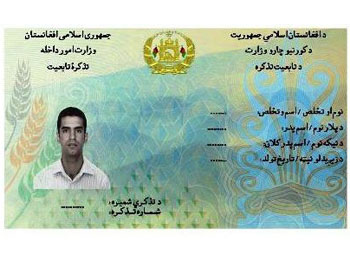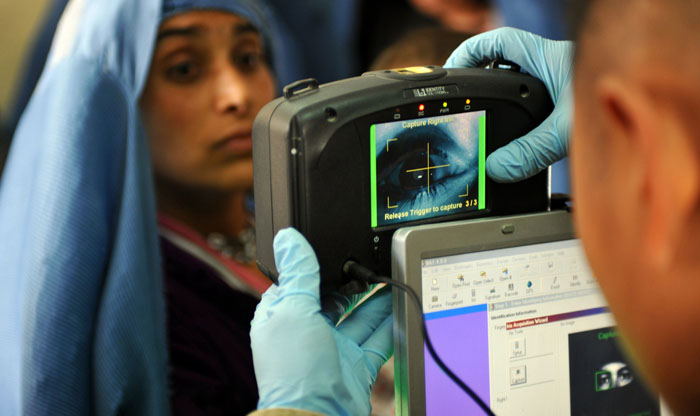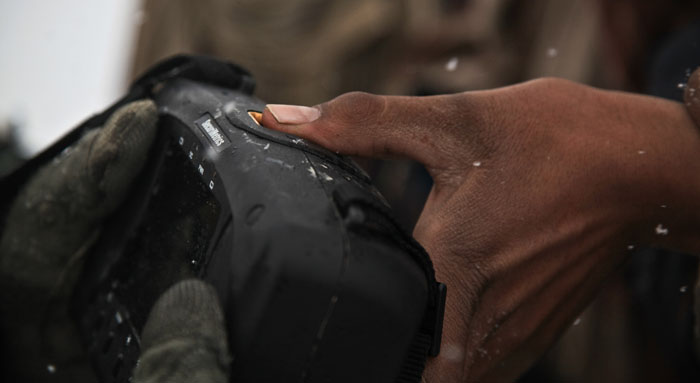Afghanistan Electronic ID card: A National or American Project?
- Category: Articles
- Written by Ahmar
- Published: Friday, 30 January 2015

A few months back, rumors of electronic ID card covered everywhere. The Afghan Government, especially Ministry of Communication and Information Technology (MC&IT) called it “a big achievement”; members of parliament and senate attacked each other on the face to mention or not to mention the ethnic information on the ID cards; but the point that no one paid attention to, is the hidden aspects of this “big success”: who uses the information of Afghan citizens which come through the ID cards?
Apparently, the electronic ID card project, which works via Electronic ID Card Distribution Authority, was started in 2008 by MC&IT & later on Ministry of Interior Affairs (MoIA) also joined the project. To display it as national project, at start it was announced that its budget will be funded from Afghan Government Development Budget. Later, MoIA wrote on its website that International Community will provide USD115 million, covering 95% of the project’s budget.
On July 31st, 2012, Roz News Agency quoted Siddiq Siddiqi, spokesperson of MoIA:
“Photo, name, date of birth and other information of cardholder has been placed in the electronic ID card.”

14 April 2012: US Army personnel collecting biometric data from a patient in Bagram Airbase. (Photo: US Army)
Apparently this project is bringing lots of facilities for Afghan citizens. For example, identification mistakes can be corrected easily; passport and driving license of individuals can be also linked to it and several other facilities. But recently publicintelligence.net published a document from US Army which unveils the so-called achievement of Afghan Government.
It is written in the start of the article:
“For years the U.S. military has been waging a biometric war in Afghanistan, working to unravel the insurgent networks operating throughout the country by collecting the personal identifiers of large portions of the population. A restricted U.S. Army guide on the use of biometrics in Afghanistan obtained by Public Intelligence provides an inside look at this ongoing battle to identify the Afghan people.”
In the prologue of U.S. Army Commander’s Guide to Biometrics in Afghanistan, it was written that currently 7000 biometric data collection devices are used all over Afghanistan. The biometric data includes anatomical and physiological behavior of human beings, but the main function of such devices covers the fingerprints, iris scans and facial photographs, name and complete identity of individual. It is also mentioned in this document, that all of these devices are connected to 150 computer servers that can exchange data with each other.
In the beginning, all of the collected data are reviewed by analysts of US military intelligence, but at the end “all biometric data collected in Afghanistan is ultimately sent back to the DOD’s Automated Biometric Identification System (ABIS) located in West Virginia, where it is stored and also shared with the Department of Homeland Security (DHS) and FBI.”

US Army high official handing over the recently built Afghan 1000 site to Spin Boldak District Chief. (Photo: US Army)
It is said that collection of biometric data is so important for US Government, which is mentioned in the document, it is recommended to the troops that “collection of biometric data from all citizens of country shall be put in the priority of their tasks in all over Afghanistan border outposts and check points”. In addition, since several years US Government has started a joint project with MoIA called Afghan 1000. As per this project documents, the goal of launching this project is to collect biometric information from 80% of country population (25 million) by end of 2012. Although the number of collected data from Afghan citizens is not disclosed yet, but one point is clear that since recent years, MoIA has started collection of biometric data through Kabul International Airport, Afghan Population Registration Department offices throughout the country and recently in Torkham and Spin Boldak borders.
Ultimately collection of biometric information doesn’t end with 80% Afghanistan’s population. It includes every living individual of this country. In 2010, during a conference for senior officials of Afghanistan on biometric information, the commander of the U.S. Army’s Task Force Biometrics Col. Craig Osborne told the attendees:
“Your iris design belongs only to you and your left and right irises are different… A name can be changed or altered illegally or even legally, but once your iris is formed at the age of six months, it cannot be altered, duplicated or forged.”
Roz News Agency has again quoted Siddiq Siddiqi: “The ID card is an advanced card with a memory chip that can record all information of the cardholder along a 7 characters password.” Meaning that Afghan electronic ID card is not just a simple card with photo and some minor information printed on it. It is a smart card, having memory card, and once connected to a computer through a card reader, all information of cardholder appears in the screen.
In a section titled “Population Management,” the U.S. Army’s guide recommends that “every person who lives within an operational area should be identified and fully biometrically enrolled with facial photos, iris scans, and all ten fingerprints (if present).” The same chapter emphasis, that collection of biometric information is not limited to rebels, but it include all population of that particular area:
“Where they live, what they do, and to which tribe or clan they belong.”

30 January 2012: US Army personnel collecting biometric data of an Afghan man in Paktia. (Photo: US Army)
In 2007, Pakistani Government in collaboration with UNHCR distributed Afghan Citizen Card to all Afghan refugees in that country, in which biometric information of 1.5 million of our refugees was collected. The main purpose of this project was to collect biometric data of Afghan citizens, but the cardholder doesn’t enjoy any facility in Pakistan. Database of the cards has been shared with US Government and some other western countries. Afghan citizens, who have contacted US Embassy in Islamabad, said that their information of Afghan Citizen Card is available with the embassy.
If we compare Afghanistan with the region or its neighboring countries, we will find that Afghanistan is counted among poorest countries in the region, but how this ruin country find ways to reach this advanced technology. Even in most of the European countries, there is no news of electronic ID card and recently UK have started distribution of electronic ID card for its citizens. Afghanistan, where we don’t have even a single standard IT school and most of engineers working in communication and internet sectors are Indians and Pakistanis. So what kind of magic stick is available with Afghan Government of Afghanistan that without having professional and technical people, they are having satellite and getting access to electronic ID cards. Col. Craig Osborne is replying to this question during his speech, “access to identity of people”, means in the name of electronic ID card collecting information of Afghan citizens by Afghan Government and respectfully sharing it with US Government.

Hi-tech printer of electronic ID card (Photo: Electronic ID Card Distribution Authority)











